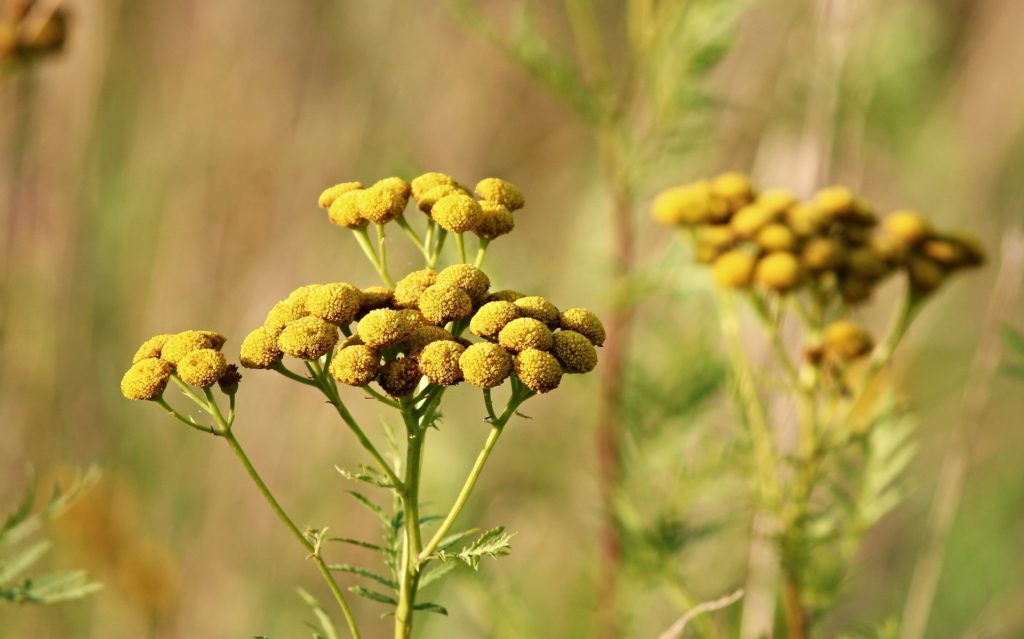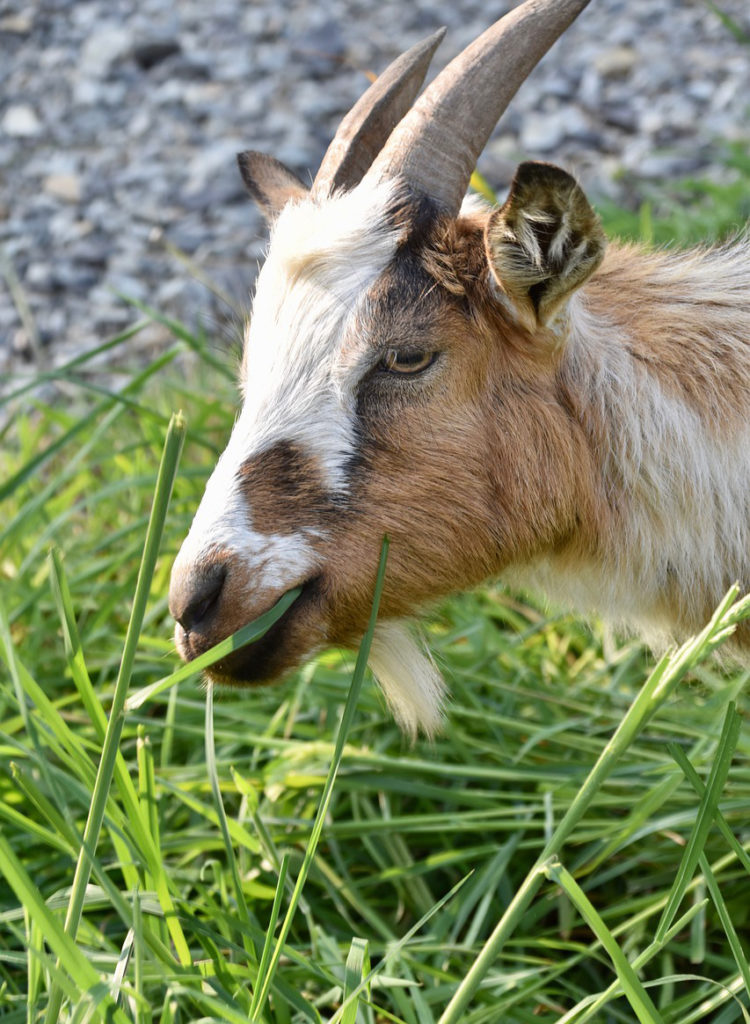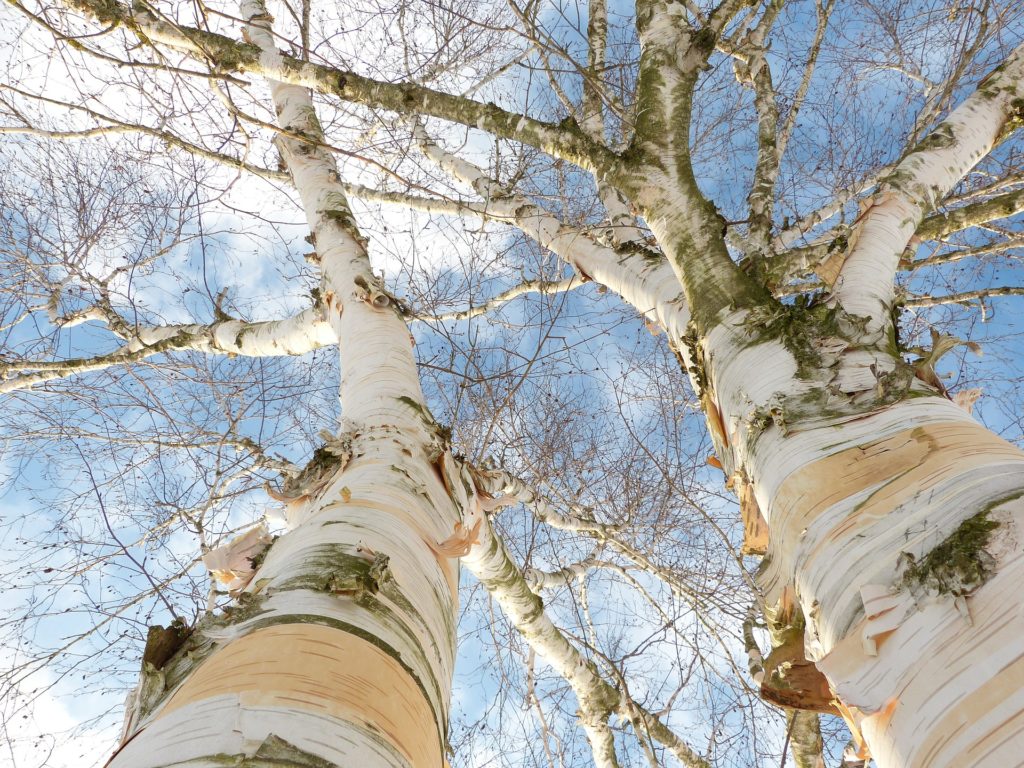Invasive vs. Native Plants: Knowing & Growing Your Riparian Area
Written by Heather J. Marshall
Invasive Species: What’s the Problem?
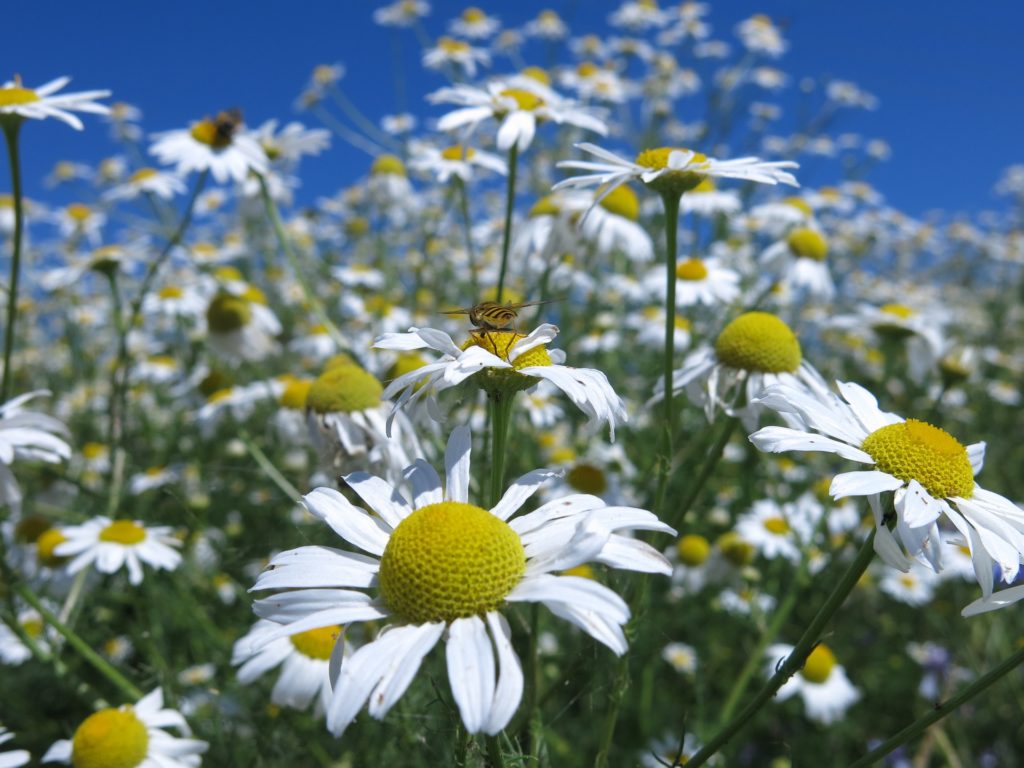
Scentless Chamomile can compete with crops (especially forages) in their early development and are
often found near waterbodies, or in places with periodic flooding. Photo from Pixabay.com
Invasive species are not necessarily bad in and of themselves, as they may:
- Be attractive to look at
- Have medicinal properties
BUT, in the wrong place, they can cause problems for various reasons:
- Ability to outcompete crops and diminish crop values
- Push out important riparian plants (which can lead to erosion, less water filtering, and less diverse wildlife habitat)
- Clog or block waterways
- Be dangerous or toxic to livestock or humans
- Draw too much water or block sunlight from an area and change the soil structure for other plants
- Indicate other problems in the environment, such as bare ground or soil that has been compacted by livestock or human traffic
Economical Impacts: Did you Know? The number one economic impact of invasive plants is on the farming sector,
both in livestock and crop production.Ecological Impacts, Did You Know? Invasive plant species play a role in 44 species (plants, birds, insects, etc)
that are considered at risk in Canada.
How Did Invasive Plants Get Here?

The diagram above shows that the majority of invasive plant species were either introduced through as
ornamental and gardening plants or through various plant products.
The Past, Present and Future of Invasive Plant Species
(based on CFIA’s Report, “Invasive Alien Plants in Canada”)
- PAST: Some of these plants have been here for over four centuries, but the greatest number of invasive species were introduced between 1800-1900
- PRESENT: A new invasive plant is introduced to Canada about every two years, due to stricter controls and regulations for imported goods
- FUTURE: Experts look at trade patterns to predict future invasive issues
- Because the US is Canada’s biggest trade partner, about 2/3 of material with the potential to introduce new invasives comes from south of the border
- Climate change will also play a role in whether or not new species are able to become established in Alberta
Management and Control of Invasive Plant Species
Dealing with weeds:
- Research best methods of control for each species
- Keep soil healthy and encourage a diversity of native species
- Be informed about methods that protect water health and safety

Main methods of control:
Be PlantWise
♣ Know your plants, as whatever you put into your garden or yard could spread to fields and riparian areas
♣ Clean equipment (e.g. Boats, ATVs, tools, work boots, tractors) that has been used in other areas — or with specific weeds
♣ Don’t plant “wildflower mixes”, bird seeds with unlabelled seeds, or unnamed seeds/bulbs promoted as “fast spreaders”
♣ Stay informed through sources like the Alberta Invasive Species Council (https://abinvasives.ca/)
♣ Encourage your neighbours and local greenhouses to sell non-invasive plants
Hand pulling or mowing:
♣ Best for plants that don’t spread by roots or rhizomes (underground stem that sends out roots and shoots)
♣ Only mow in areas that are not wet or too easily compacted
Disposal of Invasive Species:
♣ Contact your county or regional invasive species committee to learn how to get rid of invasive plants in your community. Most counties suggest burning or the landfill
♣ Place seed heads and mature flowers (and other parts that can lead to reproduction) in plastic garbage bags, rather than composting them
Problem Plants: What are some common Invasive Plants
in the Vermilion River watershed?
All of the following weeds are designated “Noxious” for Alberta, which means that they must be controlled. The other possible designation is “Prohibited Noxious”, which means they must be destroyed. Weed control benefits both you and your downstream/downwind neighbours.
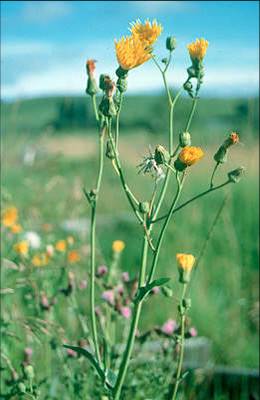
1. Sow Thistle (aka Marsh Thistle)
Sow thistle photo from ©Cow and Fish. www.cowsandfish.org
- Looks like a “tall dandelion” (up to 2 metres) with larger yellow flowers that grow in multiples on one stalk
- Common in Prairie regions and impacts crops and riparian areas (likes full sun and moist soils)
- A North Dakota study showed a density of 15 plants/square yard reduced yields by 14% in Spring wheat
- Secretes a chemical to prevent other plants/competitors from germinating
- Reproduces by seed and creeping roots (rhizomes)
- Control Methods:
- Cultivate seedlings and mature plants to exhaust root reserves
- Hand-pulling of seedlings could be easier than multiple mowings
- Sheep and cattle will eat the thistle before spines develop, and some breeds of goats will eat them at any stage
Did You Know? The Common Tansy was brought to North America from Europe in the 1600s and had a variety of medicinal or practical uses. These include: getting rid of intestinal worms, curing gout, as an insect repellant, to embalm bodies, and to help prevent gas.
Photo of Tansies from Pixabay.com
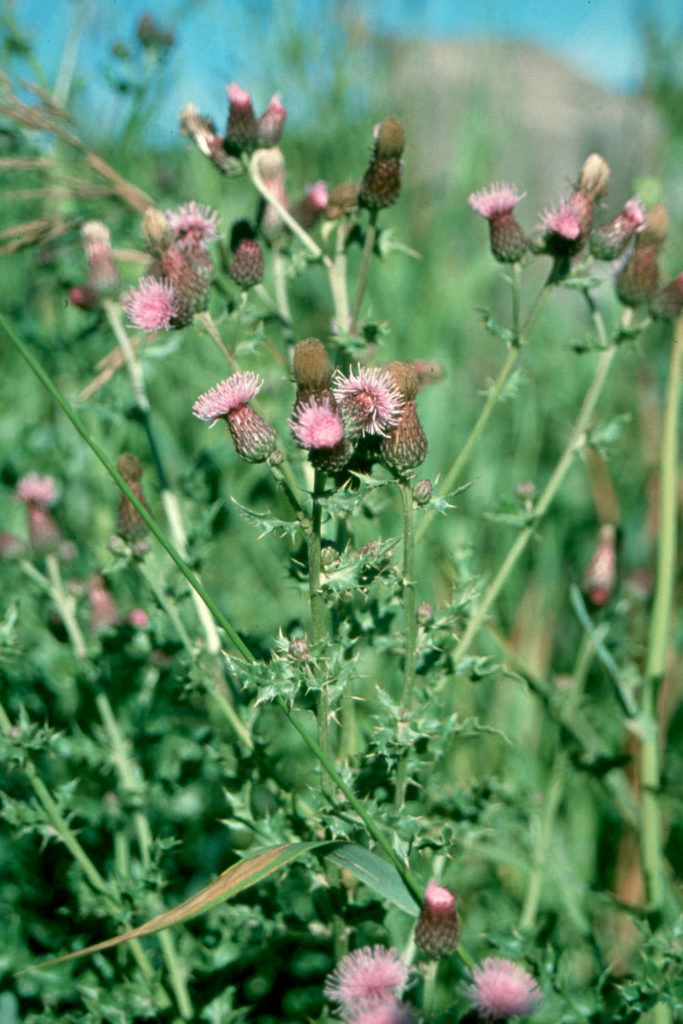
Did You Know? The Canada Thistle is not really Canadian. This plant was brought over from Europe and can survive for long periods of drought due to an extensive root system. Its seeds can also stay dormant for up to 20 years.
A report by the Canadian Food Inspection Agency said that the Prairie provinces spend an estimated $320 million in losses and treatments due to Canada Thistle’s impact on canola crops each year.
Photo from ©Cow and Fish. www.cowsandfish.org
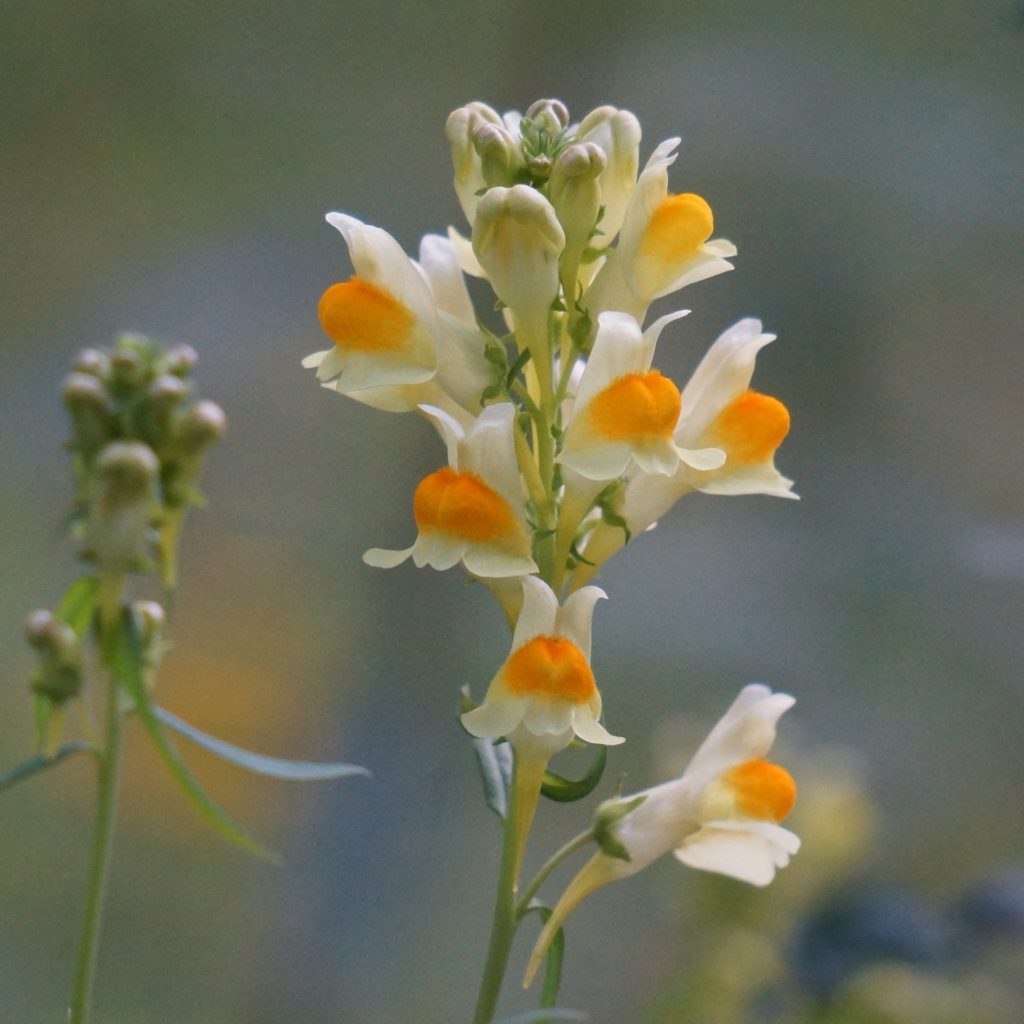
2. Yellow Toadflax (aka Butter-and-Eggs)
- Brought from Europe as an ornamental plant and is often added to “wildflower mixes”
- Resemble a snapdragon with a bright orangey center
- Creeping rhizomes and seeds form vast colonies and crowd other plants out
- Prefers moist, coarse or sandy soils, which makes it a problem in riparian areas
- Control Methods:
- Repeated cultivation can get rid of root system (remember to clean equipment after use)
- Hand pulling and mowing can get rid of seed and deplete the roots
- The Stem mining weevil has been used for control
Photo of Yellow Toadflax from Pixabay.com
Targeting Toadflax and Tansy with Grazing: A number of Canadian cities have tried pilot projects where goats are brought in to target graze invasive species in place of spraying. A young entrepreneur named Jeanette Hall is one of the Albertans spearheading this movement. She trains her flock of goats to prefer certain weeds (all of the ones mentioned here, and more) from birth through positive reinforcement. Photo from Pixabay.com
For more on her company or her work in Edmonton, go to: https://edmontonjournal.com/news/local-news/baah-bye-rundle-park-goats-depart-as-pilot-project-comes-to-end
https://organicweedcontrol.ca/
To learn more about Alberta’s regulated weeds, please go to: https://www.alberta.ca/provincially-regulated-weeds.aspx
Two Key Issues that May be Stressing Your Riparian Area
- Problem or invasive plants that are impacting the health of your crops, water, or animals
- Human or livestock traffic that is causing compaction needs to be limited or fenced off so that
native vegetation can recover and grow back
If you would like to delve deeper into assessing your site or are considering seeding or re-planting native riparian vegetation, please see:
Cows and Fish Riparian Assessment tools: https://cowsandfish.org/publications/riparian-health-assessment-and-inventory-new/
AWES Riparian Manual: https://www.awes-ab.ca/wp-content/uploads/2020/07/Riparian-Manual.pdf
Native Riparian Plants and Health
Signs that your riparian area is healthy
- A variety of species that include woody plants, sedges, rushes, and grasses
- Woody plants (see Trees and Preferred Shrubs below) in all stages of life, particularly younger ones (which indicates regeneration) and older (which indicates establishment)
- Dense stands of grasses, sedges and rushes, not just scattered individual plants
What makes wood good? The right kind of trees and shrubs will:
- Contribute to bank and shoreline stability
- Filter runoff before it enters waterbodies
- Shade and shelter other plant, livestock, and wildlife species
- *Too much dead or stunted wood = not good (a certain amount is natural)
- If woody species have been overgrazed or browsed by animals, or removed by beaver, this can
- Stress native plants — “nosedive, not thrive”
- Give place to invasive species
- If woody species have been overgrazed or browsed by animals, or removed by beaver, this can
Shrubs and trees, please! What kind are best?
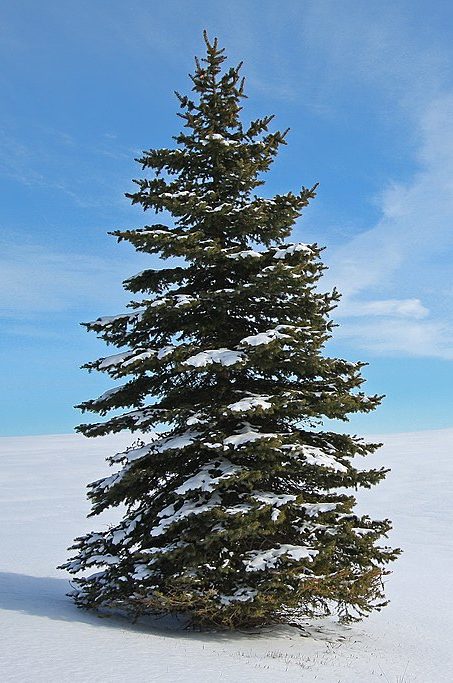
Deciduous: Aspens, poplars, birches
Conifers: Spruce and pine
Best in what type of riparian area: From a small stream to a larger river bank, lakes and wetlands these trees do well because:
- They have deep, binding root masses that are appropriate for all riparian systems
- Balsam Poplar and Trembling aspen are especially good in an area that is “bouncing back”, because they grow quickly and are tolerant to stress
- Long-lived, established trees such as Lodgepole Pine and White Spruce, also buffer the wind and provide habitat for wildlife
Photo credits: ABOVE LEFT: Paper (White) birch tree trunks rise to the sky, from Pixabay.com. ABOVE RIGHT: White spruce in winter,. Photo credit: Allen McGregor https://commons.wikimedia.org/wiki/File:White_Spruce,_Brampton,_Ontario_(5322599282).jpg
*Preferred shrubs (*Cows and Fish designation):
Examples: Willows, saskatoon, pincherry, honeysuckle, cranberry, dogwood, alder, silverberry, and chokecherry
Best in what type of riparian area: From a small stream to a larger river bank, lakes and wetlands
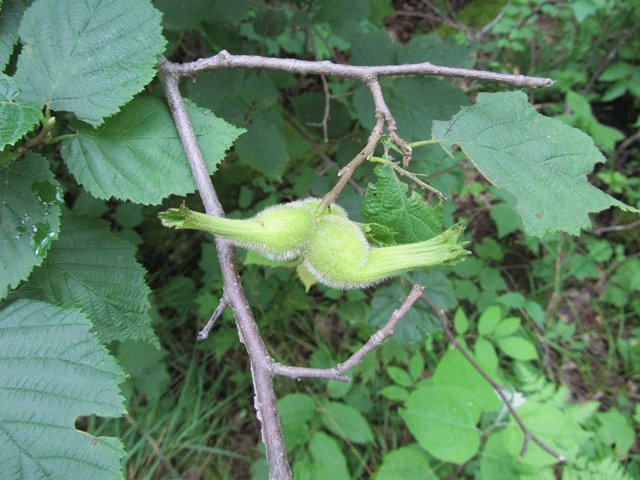
1. Beaked hazelnut
- Fast growing and suckering shrub
- Eaten by deer, squirrels, chipmunks, and several birds
- As the only native nut species in Alberta, it is also edible for humans
- Adaptable to most soil types, but don’t like flooding or extended drought
Photo credit of Beaked hazelnuts growing in their wrapping, known as an involucre: Homer Edward Price, https://commons.wikimedia.org/wiki/File:Beaked-Hazel-nuts.png
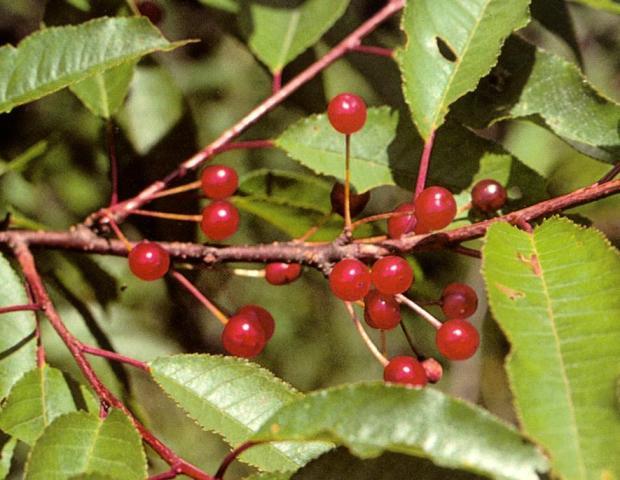
2. Pincherry (aka Bird Cherry because it is loved by songbirds)
• Quick growth to a height from 3-10 metres, with white flowers and bright red berries
• Horizontal root system helps stabilize banks
• Source of food for butterflies, squirrels, foxes, birds, deer, and skunks
• Shade intolerant, so found more along banks or forest clearings
• Pollinated by a variety of insects
Photo from: https://www.gov.mb.ca/agriculture/crops/crop-management/fruit-crops/print,pincherry-production.html
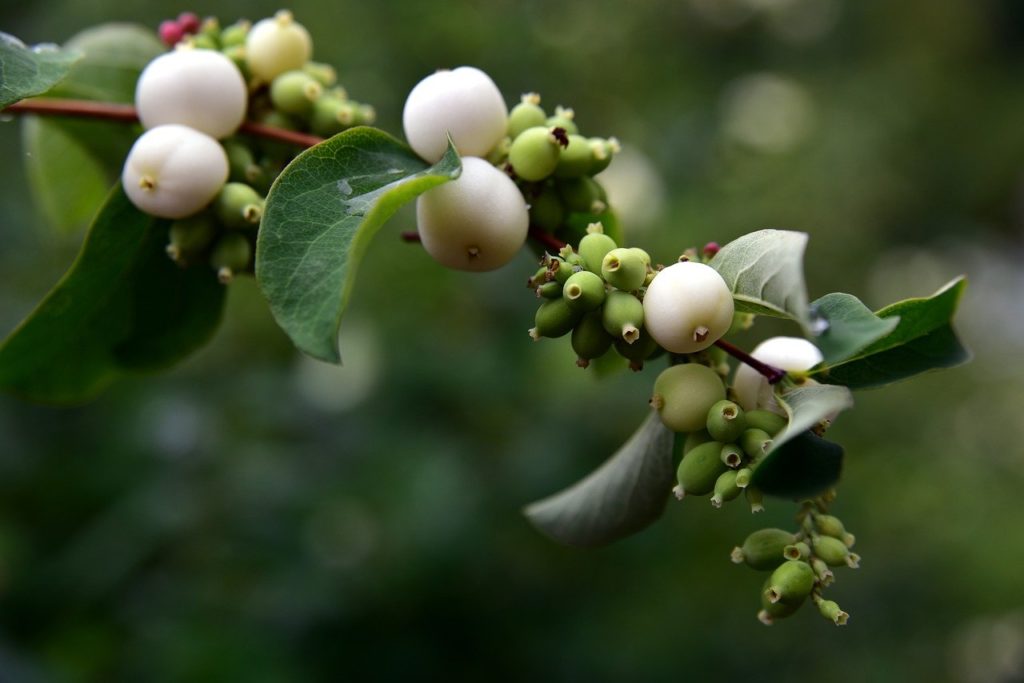
*Other shrubs (*Cows and Fish designation)
Examples: Rose, Snowberry, and Shrubby cinquefoil
Best in what type of riparian area:
- Range from good to great along wetlands, lakes, and small streams
- Are not as helpful for large stream and river systems because their root structures are not as able to prevent erosion or provide bank stability
Photo of Common Snowberry from Pixabay.com
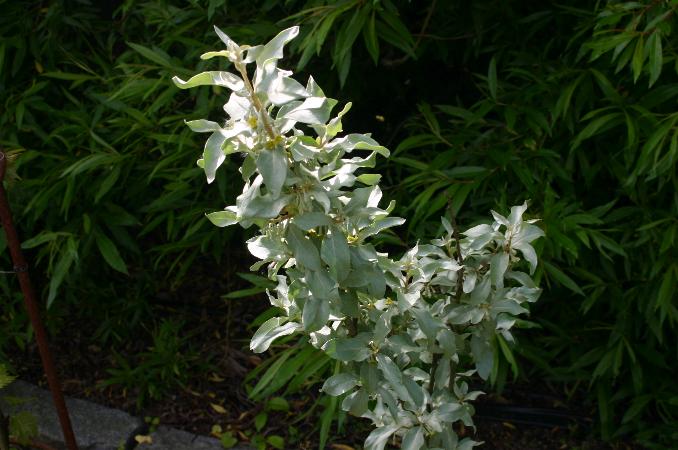
Silverberry (aka Wolf Willow)
• Distinct green-silver leaves with fragrant yellow flowers and silver coloured berries
• An important source of food for deer, moose, grouse, small mammals, and waterfowl
• Not palatable for livestock, but provides shelter
• Tolerates a wide range of habitats and climates
• Is a nitrogen fixer, which can help other nearby plants
• Not actually a willow but related to Canadian Buffaloberry (native) and Russian Olive (invasive)
Photo: Silverberry, with its distinct silver-green leaves, in bloom with yellow flowers. Photo credit: Sten Porse https://commons.wikimedia.org/wiki/File:Elaeagnus-commutata-total.JPG
3 Types of Native Grass-like plants: “Sedges have edges, rushes are round, grasses have nodes from their head to the ground”
Examples: Tall Manna Grass, Bulrush, Awned Sedge
Best in what type of riparian area:
• Range from good to great along wetlands, lakes, and small streams
• Stabilize banks and filter runoff before it enters a waterbody
• Not as helpful for large streams or river systems because their root structures are not as able to prevent erosion or provide bank stability
SEDGES: “Sedges have edges”: Edges of sedge plants are usually triangular and without joints
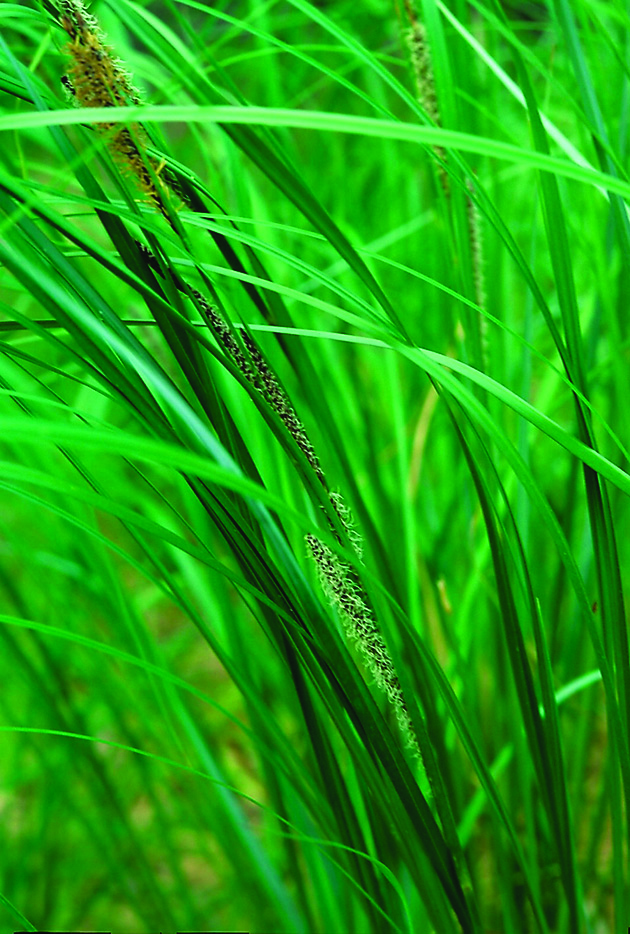
♣ Water Sedge:
- Looks grass-like and has 75% of its biomass below ground
- Amazing ability to grow in low oxygen areas, which is why they do well in wetlands
- Provides food for many small mammals, waterfowl, moose, caterpillars, and are an important food source for bears after they come out of hibernation
- Helps stabilize shorelines
Other examples: Awned sedge, Beaked sedge,
Broad fruited sedge
Water sedge photo credit: ©Cow and Fish. www.cowsandfish.org
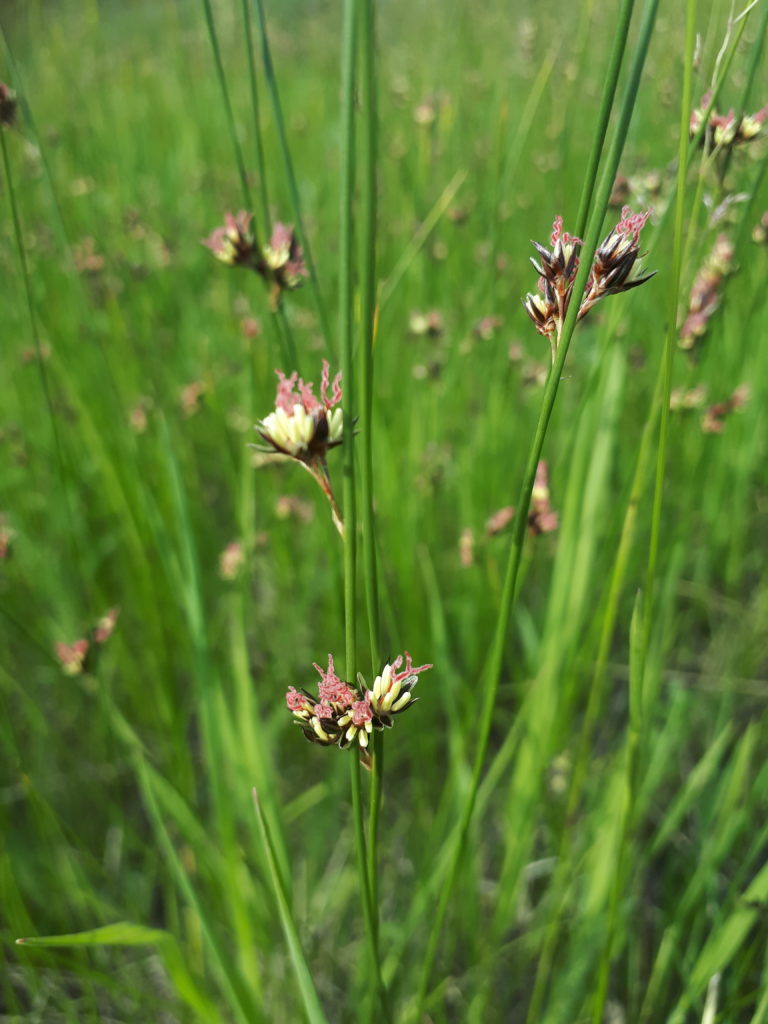
RUSHES: “Rushes are round”
♣ Baltic Rush
• Does well in a wide range of soils
• Stem will be grazed by deer or (at times) livestock when young, seed is eaten by various waterfowl, muskrats, and rushes provide habitat by birds and small mammals
Other examples: Small-fruited bulrush, Common great bulrush, Prairie bulrush
Photo credit of Baltic Rush: ©Cow and Fish. www.cowsandfish.org
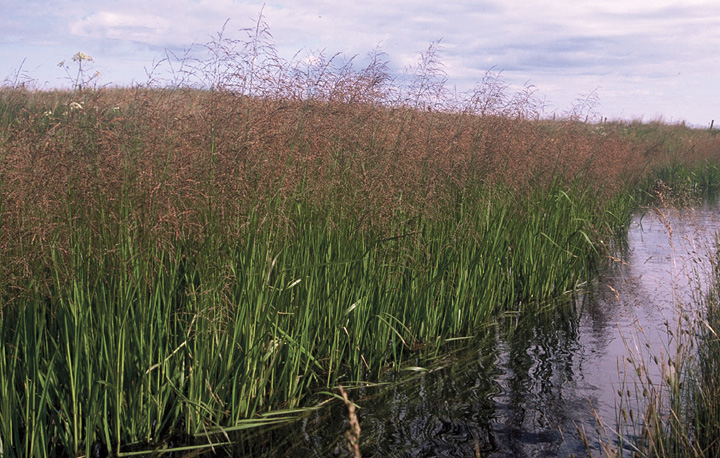
GRASSES: “Grasses have nodes from their head to the ground”
♣ Tall Manna Grass
- Can grow up to 1.2 metres and thrives on the edges of ponds, lakes, sloughs, wetlands, and rivers
- Food for many mammals but not good for cattle
Other examples: Tufted hairgrass, Reed Canary grass, Marsh Reed Grass (aka Bluejoint), Slough grass
Photo credit of Tall Manna Grass: ©Cow and Fish. www.cowsandfish.org
FORBS OR WILDFLOWERS
Best in what type of riparian area:
- Like Native grasses, forbs and wildflowers are helpful along wetlands, lakes, and small streams
- Not as helpful for large stream or river systems because their root structures are not as able to prevent erosion or provide bank stability
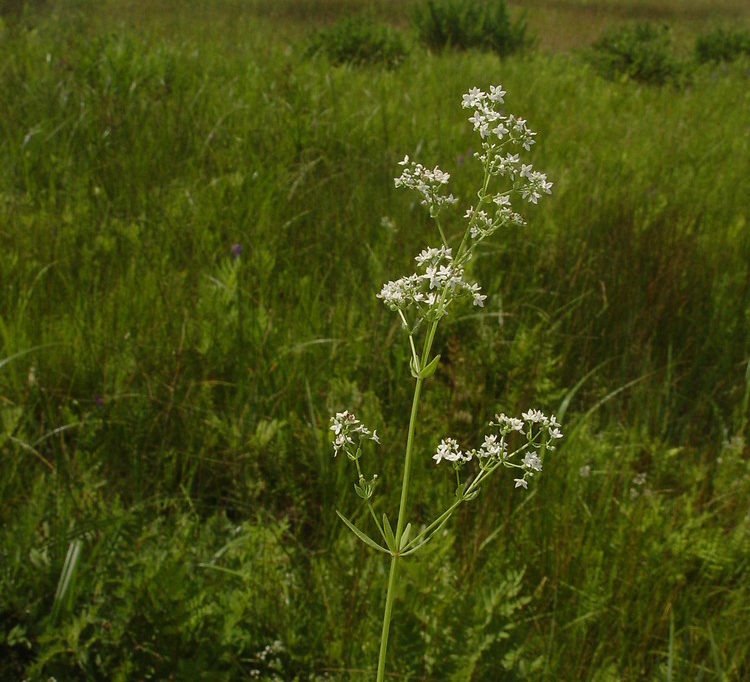
♣ Northern Bedstraw
Thrives on the border of wetlands and moist soils and grows from 20-60 cm
Branches off in clusters of tiny white/cream coloured flowers with 4 pointy petals in cross shape
Did You Know? Northern Bedstraw got its name because it was used in the past for stuffing mattresses or pillows. Juice from the young plant was a balm for sunburns or insect bites and its leaves were boiled for tea. As a relative of the coffee plant, its nutlets can be dried and used as a coffee substitute.
Photo credit: Don Cameron 2020, https://gobotany.nativeplanttrust.org/species/galium/boreale/
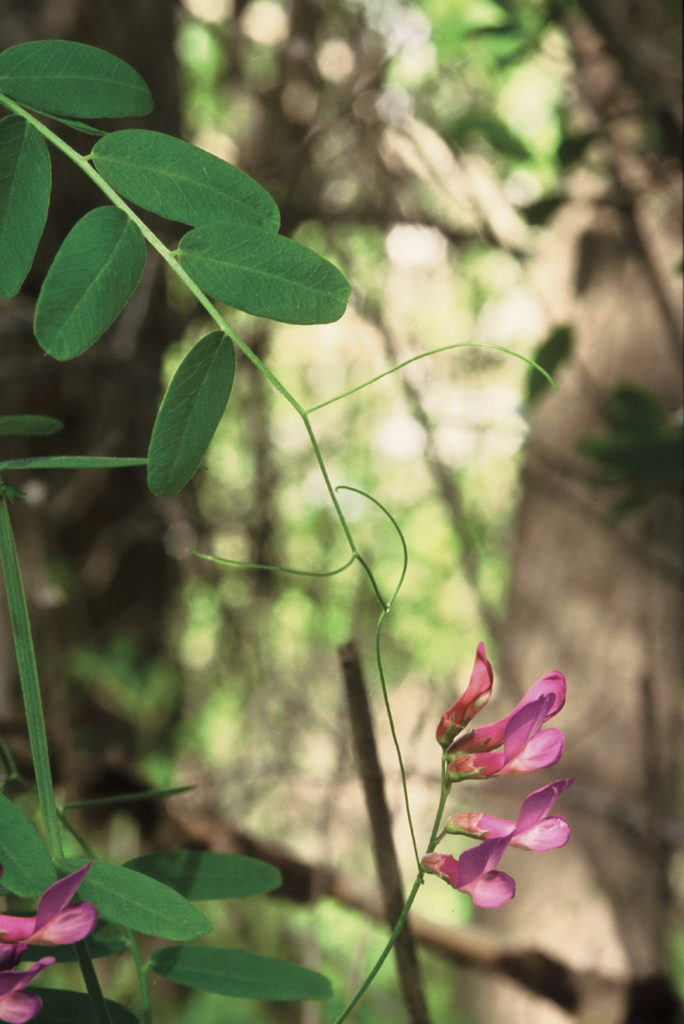
♣ Wild Vetch (aka American Vetch or Purple Vetch)*
- Fixes nitrogen (pea family) and can be used as a cover crop
- Likes moist soils and is adapted to every natural region in Alberta
- Enjoyed by various livestock as well as by birds and wildlife
- Was used by indigenous peoples as poultice for insect bites, in sweat houses, to help horses’ endurance, as an aphrodisiac, and for good luck
* Please note: There are look-alike vetches, such as Cow/Blue Vetch that can also be used as cover crops, but become problematic or invasive
Photo of American Vetch from ©Cow and Fish. www.cowsandfish.org
Other examples: Star flowered Solomon’s Seal, Cow or water parsnip, Water hemlock, Common horsetail
INTRODUCED GRASSES
Best in what type of riparian area:
- Mostly helpful for intermittent streams and some wetlands
♣ Kentucky blue grass, Timothy, and Smooth brome
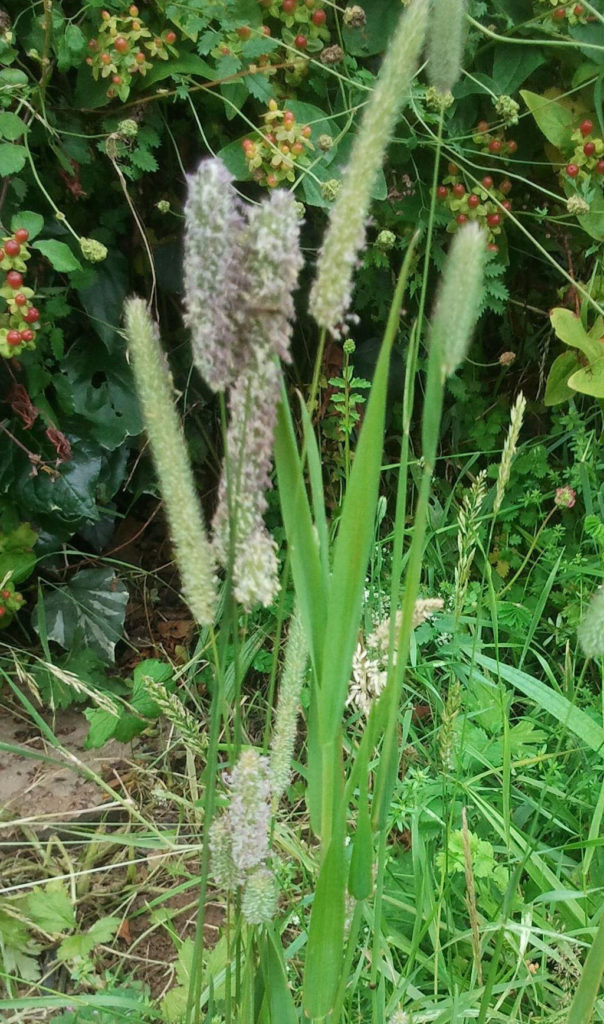
Timothy (grass) was introduced from Europe. Photo from Blokenearexeter, CC0, via Wikimedia Commons https://commons.wikimedia.org/wiki/File:Timothy_grass.jpg
Conclusion & Summary
Invasive Species are problematic because they are out of their natural habitat and can:
- Outcompete crops and diminish crop values
- Push out important riparian plants (which can lead to erosion, less water filtering, and less wildlife habitat)
Native plants are important in riparian areas because they:
- Have deeper roots which helps stabilize banks and shorelines
- Filter runoff before it enters a waterbody
- Provide shelter for livestock, wildlife, and other plants
Stay informed about your role in keeping weeds under control for the sake of your own riparian area — and for those living downwind or downstream. For more information about how to keep your riparian area healthy, please contact Cows and Fish at www.cowsandfish.org or call (403) 381-5538.
Special thanks to Tonya Lwiwski from Cows and Fish for her input – especially about Riparian Plants and their importance. I referenced a collaborative presentation put together by Cows and Fish, Lamont County, and the VRWA called, “Riparian Buffers: What’s growing next to your creeks — is it the right stuff?” This presentation and blog were made possible by a collaborative grant provided by the Canadian Agricultural Partnership.


Heather J. Marshall is a freelance writer and graphic designer. Her main interests are local food and history, human connection to the environment, and biographical stories. To contact Heather, please go to: hmmcreate.myportfolio.com

